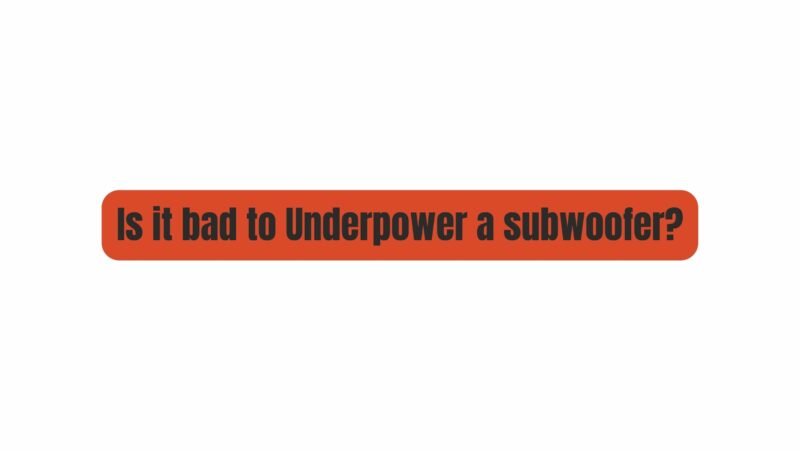Subwoofers are the heartbeat of the bass in any audio system, delivering deep, impactful low-frequency sounds that can transform your audio experience. When it comes to powering subwoofers, enthusiasts often debate whether it’s worse to underpower or overpower them. In this comprehensive article, we will focus on the question: Is it bad to underpower a subwoofer? We will explore what underpowering means, the potential consequences, and the myths surrounding this practice.
Understanding Subwoofer Power Handling
Before diving into the topic, it’s crucial to understand the concept of subwoofer power handling. Power handling is a specification that defines the amount of electrical power a subwoofer can handle continuously (RMS) without sustaining damage. This specification is typically measured in watts and is crucial for matching amplifiers to subwoofers effectively.
When a subwoofer is underpowered, it means that the amplifier delivering power to it is not reaching the subwoofer’s RMS power handling capability. The amplifier is providing less power than what the subwoofer can handle without being damaged.
The Myth of Underpowering Subwoofers
There is a common myth among audio enthusiasts that underpowering a subwoofer is inherently bad because it can lead to damage. The logic behind this myth is that if the amplifier isn’t providing enough power, the subwoofer will attempt to play sounds beyond its capabilities, causing distortion and potentially damaging the subwoofer.
The Reality of Underpowering Subwoofers
While the myth suggests that underpowering a subwoofer is always bad, the reality is more nuanced. Underpowering a subwoofer is not inherently damaging, but it can have consequences depending on how it’s managed.
- Reduced Output: The most noticeable consequence of underpowering a subwoofer is reduced output. When the amplifier doesn’t deliver enough power, the subwoofer won’t reach its full potential in terms of volume and impact. This can result in a lackluster bass performance.
- Distortion and Clipping: Underpowering can indeed lead to distortion, but not necessarily because the subwoofer is being damaged. Instead, the distortion occurs when the amplifier is pushed to its limits in an attempt to achieve higher volume levels. The amplifier may clip the audio signal, which produces harsh, distorted sound.
- Overheating Amplifier: In some cases, underpowering a subwoofer can strain the amplifier as it tries to work harder to meet the subwoofer’s demands. This excessive workload can lead to the amplifier overheating or triggering its protection circuitry.
- Long-Term Impact: While underpowering alone is unlikely to damage a subwoofer, if combined with high levels of distortion and continuous operation, it can potentially lead to stress on the subwoofer’s components over time. This stress may result in wear and tear, reducing the subwoofer’s lifespan.
Properly Managing Underpowered Subwoofers
If you find yourself in a situation where underpowering a subwoofer is unavoidable, there are ways to manage it effectively without causing damage or sacrificing audio quality:
- Use High-Quality Audio Sources: Ensure that the audio source material is of high quality. Poorly recorded or highly compressed audio files are more likely to introduce distortion when the amplifier is underpowered.
- Limit Volume Levels: Avoid cranking the volume to the maximum, especially when underpowering a subwoofer. Lower volumes are less likely to push the amplifier to its limits and introduce distortion.
- Use a Subwoofer with a Lower RMS Rating: If underpowering is a concern, consider using a subwoofer with a lower RMS power handling capability. This will make it easier for the amplifier to provide sufficient power without overexertion.
- Invest in a More Powerful Amplifier: If possible, upgrading to a more powerful amplifier that matches the subwoofer’s RMS rating is the ideal solution to avoid underpowering altogether.
Conclusion
In conclusion, underpowering a subwoofer is not inherently bad or damaging. Instead, it primarily leads to reduced output and the potential for distortion. The critical factor is how underpowering is managed. By being mindful of volume levels, using high-quality audio sources, and avoiding prolonged operation at high distortion levels, you can effectively use an underpowered subwoofer without causing harm.
It’s important to remember that the ultimate goal is to create an audio system that delivers the best possible sound quality and listening experience. If underpowering compromises your audio experience, consider upgrading your amplifier or choosing a subwoofer with a lower power handling capability that better matches your existing equipment. With proper care and attention, you can enjoy your subwoofer and audio system to their fullest potential, regardless of whether they are underpowered or not.


